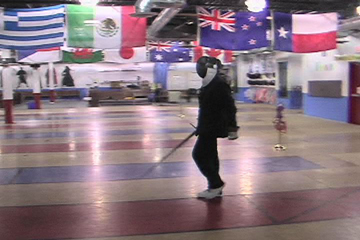
Historical Background

Historical Background
| About Historical Background Longsword Combat The Rise of the Rapier Misconceptions Reconstruction WMA Practice What HES Is Not Bouts Home |
Reconstruction of
historical European martial arts would not be possible had period fighting
masters not left detailed instruction manuals. The earliest such instruction
book – in fact, the oldest known martial arts manual from anywhere in the
world – was written in Germany around 1300. Known by its call number in
the Royal Armouries of Leeds, England, the manuscript "I.33" details, with
lavish illustrations, how to fence with the short sword and buckler, a deadly weapon
combination typical of the middle ages. (Note that the term fencing, from the Latin defendere via the French defense, originally meant warding, defending, or
fighting in general; only in modern times has the general meaning been limited
to swordplay as a sport.) In the 12th and 13th centuries, the period in which plate armor came to be increasingly used on the battlefield, a new, longer, two-handed sword, the longsword, evolved. Longer both in the blade and handle (generally between 3.5 and 4.5 feet) and generally more tapered than earlier single-handed swords, the longsword (and its variants, the hand-and-a-half or bastard sword, and the greatsword) was effective both as a cutting weapon and as a thrusting weapon, able to pierce into the joints of plate armor. It was also used for unarmored combat. The quintessential knightly weapon and symbol of chivalry, the longsword was used both in war and in civilian and judicial duels from the 13th through the 16th centuries – the high middle ages and Renaissance. Late in the 16th century, as it waned in significance on the battlefield due to changing tactics in warfare, blunted longswords became a popular sporting weapon in fencing clubs or guilds, such as the Marxbruder and Federfechter in Germany. The longsword is the first European weapon whose use was amply documented in numerous texts from across Europe. As a result, modern practitioners working in many countries have been able to reconstruct the martial arts of longsword fencing with a high degree of confidence and consensus. ("Arts," plural, because there were distinctive regional variants of this weapon style – see next page.) Next page: Longsword Combat |
All material copyright 2005
Eric Wargo